Embodied Energy Use in China’s Transportation Sector: A Multi-Regional Input–Output Analysis
Abstract
:1. Introduction
2. Method and Data Processing
2.1. MRIO Model
2.2. Data Processing
3. Results
3.1. Spatial Distribution of the Embodied Energy Use
3.2. Energy Use Embodied in Intersectoral Flows and Interprovincial Trade
3.2.1. Intersectoral Analysis
3.2.2. Interprovincial Analysis
- The provinces and cities located in the eastern coastal areas have a relatively developed economy, but they are short of resources. To support their abundant economic activities, a lot of petroleum and electricity need to be transferred from the resource-intensive provinces that are located in central and western China. Inner Mongolia, Hebei, and Liaoning are rich in natural resources. In addition, Shanghai is the largest port city in China. It trades goods with other provinces frequently. For many provinces, the energy use embodied in the transport sector’s imports mainly comes from Shanghai because it supplies a lot of products to the other regions through transportation.
- Based on the spatial distributions of the embodied energy transfers of the TS, we find a geographically close phenomenon between a province and its frequently exchanging regions. It is easy to understand that a close geography can facilitate the transportation of products and services. Thus, provinces are more likely to interact with the neighbors.
4. Discussions and Policy Implications
4.1. Discussions
- Sectoral perspective
- Provincial perspective
4.2. Policy Implications
- Sectoral policy
- Regional policy
5. Conclusions
- Intermediate use contributes the most to the energy consumption of the transport sector in most provinces, which indicates that the transport sector mainly serves in the delivery of products and services among sectors and provinces. The contributions of final uses are various in different provinces, where consumptions of households and government are the main factors in all provinces.
- Regional heterogeneity is one of the features in the TS’s EU in China. In most eastern provinces, the transport sector has high embodied EC and relatively low embodied energy intensity, while most provinces in central and western regions have relatively low embodied EU and high embodied energy intensity. Further, the provinces are divided into four types based on the embodied EC and the embodied energy intensity. Such division would help central and provincial governments to implement measures specific to each province.
- From the supply side of the TS, most EU was embodied in supplies from the petroleum refining, coking, etc. sector (S11), the electricity and hot water production and supply sector (S22), the other services sector (S27), and the transport equipment sector (S17). From its demand side, the TS offers most of the embodied energy to the other services sector (S27), the construction sector (S24), the wholesale, retailing and hotel, restaurants sector (S26), and the chemical sector (S12). Additionally, the TS is a net embodied energy supplier to many other sectors, which demonstrates that the embodied EU of other sectors would be decreased if the energy consumption of transportation can be reduced.
- From the perspective of interprovincial trade, energy embodied in the TS flows from resource-intensive provinces located in central and western China to resource-deficient provinces in eastern China. Being the largest port city in China, Shanghai exports the most embodied energy of the TS. In addition, a close geographical connection exists in the interprovincial energy transfer embodied in the TS.
- Finally, policy suggestions are provided to improve the status of the transport sector’s energy consumption, such as adopting advanced technologies and vehicles, optimizing transport modes and energy structure, and increasing public awareness of energy conversion, instead of reducing transport activities.
Author Contributions
Funding
Institutional Review Board Statement
Informed Consent Statement
Data Availability Statement
Acknowledgments
Conflicts of Interest
References
- Chung, W.; Zhou, G.; Yeung, I.M. A study of energy efficiency of transport sector in China from 2003 to 2009. Appl. Energ. 2013, 112, 1066–1077. [Google Scholar] [CrossRef]
- Liu, L.; Wang, K.; Wang, S.; Zhang, R.; Tang, X. Assessing energy consumption, CO2 and pollutant emissions and health benefits from China’s transport sector through 2050. Energy Policy 2018, 116, 382–396. [Google Scholar] [CrossRef]
- CESY. China Energy Statistical Yearbooks; China Statistics Press: Beijing, China, 2019. [Google Scholar]
- Mi, Z.; Meng, J.; Guan, D.; Shan, Y.; Liu, Z.; Wang, Y.; Feng, K.; Wei, Y.-M. Pattern changes in determinants of Chinese emissions. Environ. Res. Lett. 2017, 12, 074003. [Google Scholar] [CrossRef]
- Dvorak, Z.; Rehak, D.; David, A.; Cekerevac, Z. Qualitative Approach to Environmental Risk Assessment in Transport. Int. J. Environ. Res. Public Health 2020, 17, 5494. [Google Scholar] [CrossRef]
- Huang, J.; Guo, X.B. Research progress on the health effects of traffic-related air pollution. China Environ. Sci. 2014, 34, 1592–1598. [Google Scholar]
- Loo, B.P.; Li, L. Carbon dioxide emissions from passenger transport in China since 1949: Implications for developing sustainable transport. Energy Policy 2012, 50, 464–476. [Google Scholar] [CrossRef]
- Feng, X.S.; Cai, B.F. A review on policies of reducing carbon emission in China’s urban road transport system. China Popul. Resour. Environ. 2012, 22, 10–15. [Google Scholar]
- Lv, T.; Wu, X. Using panel data to evaluate the factors affecting transport energy consumption in China’s three regions. Int. J. Environ. Res. Public Health 2019, 16, 555. [Google Scholar] [CrossRef] [Green Version]
- Zhou, G.; Chung, W.; Zhang, X. A study of carbon dioxide emissions performance of China’s transport sector. Energy 2013, 50, 302–314. [Google Scholar] [CrossRef]
- Yin, X.; Chen, W.; Eom, J.; Clarke, L.E.; Kim, S.H.; Patel, P.L.; Yu, S.; Kyle, G.P. China’s transportation energy consumption and CO2 emissions from a global perspective. Energy Policy 2015, 82, 233–248. [Google Scholar] [CrossRef]
- Wang, H.; Ou, X.; Zhang, X. Mode, technology, energy consumption, and resulting CO2 emissions in China’s transport sector up to 2050. Energy Policy 2017, 109, 719–733. [Google Scholar] [CrossRef]
- Ren, L.; Zhou, S.; Ou, X. Life-Cycle energy consumption and greenhouse-gas emissions of hydrogen supply chains for fuel-cell vehicles in China. Energy 2020, 209, 118482. [Google Scholar] [CrossRef]
- Yaqoob, H.; Teoh, Y.H.; Goraya, T.S.; Sher, F.; Jamil, M.A.; Rashid, T.; Yar, K.A. Energy evaluation and environmental impact assessment of transportation fuels in Pakistan. Case Stud. Chem. Environ. Eng. 2021, 3, 100081. [Google Scholar] [CrossRef]
- Zhou, G.; Chung, W.; Zhang, Y. Measuring energy efficiency performance of China’s transport sector: A data envelopment analysis approach. Expert. Syst. Appl. 2014, 41, 709–722. [Google Scholar] [CrossRef]
- Liu, Z.; Qin, C.X.; Zhang, Y.J. The energy-environment efficiency of road and railway sectors in China: Evidence from the provincial level. Ecol. Indic. 2016, 69, 559–570. [Google Scholar] [CrossRef]
- Liu, H.; Zhang, Y.; Zhu, Q.; Chu, J. Environmental efficiency of land transportation in China: A parallel slack-based measure for regional and temporal analysis. J. Clean. Prod. 2017, 142, 867–876. [Google Scholar] [CrossRef]
- Feng, C.; Wang, M. Analysis of energy efficiency in China’s transportation sector. Renew. Sust. Energ. Rev. 2018, 94, 565–575. [Google Scholar] [CrossRef]
- Zhu, Q.; Li, X.; Li, F.; Wu, J.; Zhou, D. Energy and environmental efficiency of China’s transportation sectors under the constraints of energy consumption and environmental pollutions. Energy Econ. 2020, 89, 104817. [Google Scholar] [CrossRef]
- Wei, F.; Zhang, X.; Chu, J.; Yang, F.; Yuan, Z. Energy and environmental efficiency of China’s transportation sectors considering CO2 emission uncertainty. Transp. Res. Part D Transp. Environ. 2021, 97, 102955. [Google Scholar] [CrossRef]
- Mraihi, R.; ben Abdallah, K.; Abid, M. Road transport-related energy consumption: Analysis of driving factors in Tunisia. Energy Policy 2013, 62, 247–253. [Google Scholar] [CrossRef]
- Achour, H.; Belloumi, M. Decomposing the influencing factors of energy consumption in Tunisian transportation sector using the LMDI method. Transp. Policy 2016, 52, 64–71. [Google Scholar] [CrossRef]
- Isik, M.; Sarica, K.; Ari, I. Driving forces of Turkey’s transportation sector CO2 emissions: An LMDI approach. Transp. Policy 2020, 97, 210–219. [Google Scholar] [CrossRef]
- Chen, W.; Lei, Y. Path analysis of factors in energy-related CO2 emissions from Beijing’s transportation sector. Transp. Res. Part D Transp. Environ. 2017, 50, 473–487. [Google Scholar] [CrossRef]
- Li, Z.; Meng, N.; Yao, X. Sustainability performance for China’s transportation industry under the environmental regulation. J. Clean. Prod. 2017, 142, 688–696. [Google Scholar] [CrossRef]
- Li, H.; Gozgor, G.; Lau, C.K.M.; Paramati, S.R. Does tourism investment improve the energy efficiency in transportation and residential sectors? Evidence from the OECD economies. Environ. Sci. Pollut. Res. 2019, 26, 18834–18845. [Google Scholar] [CrossRef] [PubMed]
- Wang, Q.; Wang, S.; Li, R. Determinants of decoupling economic output from carbon emission in the transport sector: A comparison study of four municipalities in China. Int. J. Environ. Res. Public Health 2019, 16, 3729. [Google Scholar] [CrossRef] [Green Version]
- Xu, J.H.; Guo, J.F.; Peng, B.; Nie, H.; Kemp, R. Energy growth sources and future energy-saving potentials in passenger transportation sector in China. Energy 2020, 206, 118142. [Google Scholar] [CrossRef]
- Liu, J.; Li, S.; Ji, Q. Regional differences and driving factors analysis of carbon emission intensity from transport sector in China. Energy 2021, 224, 120178. [Google Scholar] [CrossRef]
- Chen, Z.M.; Chen, G.Q. Demand-Driven energy requirement of world economy 2007: A multi-region input–output network simulation. Commun. Nonlinear Sci. 2013, 18, 1757–1774. [Google Scholar] [CrossRef]
- Usubiaga, A.; Acosta-Fernández, J. Carbon emission accounting in MRIO models: The territory vs. the residence principle. Econ. Syst. Res. 2015, 27, 458–477. [Google Scholar] [CrossRef]
- Wu, D.; Liu, J. Multi-Regional input-output (MRIO) study of the provincial ecological footprints and domestic embodied footprints traded among China’s 30 provinces. Sustainability 2016, 8, 1345. [Google Scholar] [CrossRef] [Green Version]
- Wang, F.; Liu, B.; Zhang, B. Embodied environmental damage in interregional trade: A MRIO-based assessment within China. J. Clean. Prod. 2017, 140, 1236–1246. [Google Scholar] [CrossRef] [Green Version]
- Zhan, L.; Lei, Y.; Li, L.; Ge, J. Interprovincial transfer of ecological footprint among the region of Jing-Jin-Ji and other provinces in China: A quantification based on MRIO model. J. Clean. Prod. 2019, 225, 304–314. [Google Scholar] [CrossRef]
- Chang, Y.; Ries, R.J.; Wang, Y. The embodied energy and environmental emissions of construction projects in China: An economic input–output LCA model. Energy Policy 2010, 38, 6597–6603. [Google Scholar] [CrossRef]
- Chang, Y.; Ries, R.J.; Wang, Y. Life-cycle energy of residential buildings in China. Energy Policy 2013, 62, 656–664. [Google Scholar] [CrossRef]
- Li, Y.; Zhang, B.; Wang, B.; Wang, Z. Evolutionary trend of the coal industry chain in China: Evidence from the analysis of IO and APL model. Resour. Conserv. Recycl. 2019, 145, 399–410. [Google Scholar] [CrossRef]
- Peng, J.; Xie, R.; Lai, M. Energy-Related CO2 emissions in the China’s iron and steel industry: A global supply chain analysis. Resour. Conserv. Recycl. 2018, 129, 392–401. [Google Scholar] [CrossRef]
- Hue, P.T.; Tuyet, N.T.A. Evaluation of energy intensity of transport service sectors in Vietnam. Environ. Sci. Pollut. Res. 2021, 28, 11860–11868. [Google Scholar] [CrossRef] [PubMed]
- Wiedmann, T.; Wilting, H.C.; Lenzen, M.; Lutter, S.; Palm, V. Quo Vadis MRIO? Methodological, data and institutional requirements for multi-region input–output analysis. Ecol. Econ. 2011, 70, 1937–1945. [Google Scholar] [CrossRef]
- Wiedmann, T.; Wilting, H.C.; Lutter, S.; Palm, V.; Giljum, S.; Wadeskog, A.; Nijdam, D. Development of a methodology for the assessment of global environmental impacts of traded goods and services. In Environment Agency UK and SKEP Network; SCHO1009BRAM-EP; Environment Agency Publication: London, UK, 2009. [Google Scholar]
- Chen, Z.M.; Chen, G.Q. Virtual water accounting for the globalized world economy: National water footprint and international virtual water trade. Ecol. Indic. 2013, 28, 142–149. [Google Scholar] [CrossRef]
- Lenzen, M.; Pade, L.L.; Munksgaard, J. CO2 multipliers in multi-region input-output models. Econ. Syst. Res. 2004, 16, 391–412. [Google Scholar] [CrossRef]
- Zhang, B.; Qiao, H.; Chen, Z.M.; Chen, B. Growth in embodied energy transfers via China’s domestic trade: Evidence from multi-regional input–output analysis. Appl. Energy 2016, 184, 1093–1105. [Google Scholar] [CrossRef]
- Zhang, B.; Chen, Z.M.; Xia, X.H.; Xu, X.Y.; Chen, Y.B. The impact of domestic trade on China’s regional energy uses: A multi-regional input–output modeling. Energy Policy 2013, 63, 1169–1181. [Google Scholar] [CrossRef]
- Mi, Z.; Meng, J.; Guan, D.; Shan, Y.; Song, M.; Wei, Y.M.; Liu, Z.; Hubacek, K. Chinese CO2 emission flows have reversed since the global financial crisis. Nat. Commun. 2017, 8, 1712. [Google Scholar] [CrossRef]
- Su, B.; Huang, H.C.; Ang, B.W.; Zhou, P. Input–Output analysis of CO2 emissions embodied in trade: The effects of sector aggregation. Energy Econ. 2010, 32, 166–175. [Google Scholar] [CrossRef]
- Guo, J.E.; Zhang, Z.; Meng, L. China’s provincial CO2 emissions embodied in international and interprovincial trade. Energy Policy 2012, 42, 486–497. [Google Scholar] [CrossRef]
- Guo, B.; Geng, Y.; Franke, B.; Hao, H.; Liu, Y.; Chiu, A. Uncovering China’s transport CO2 emission patterns at the regional level. Energy Policy 2014, 74, 134–146. [Google Scholar] [CrossRef]
- Ouyang, X.; Sun, C. Energy savings potential in China’s industrial sector: From the perspectives of factor price distortion and allocative inefficiency. Energy Econ. 2015, 48, 117–126. [Google Scholar] [CrossRef]
- Ouyang, X.; Lin, B. Impacts of increasing renewable energy subsidies and phasing out fossil fuel subsidies in China. Renew. Sustain. Energy Rev. 2014, 37, 933–942. [Google Scholar] [CrossRef]
- Zhang, X.; Rao, R.; Xie, J.; Liang, Y. The current dilemma and future path of China’s electric vehicles. Sustainability 2014, 6, 1567–1593. [Google Scholar] [CrossRef] [Green Version]
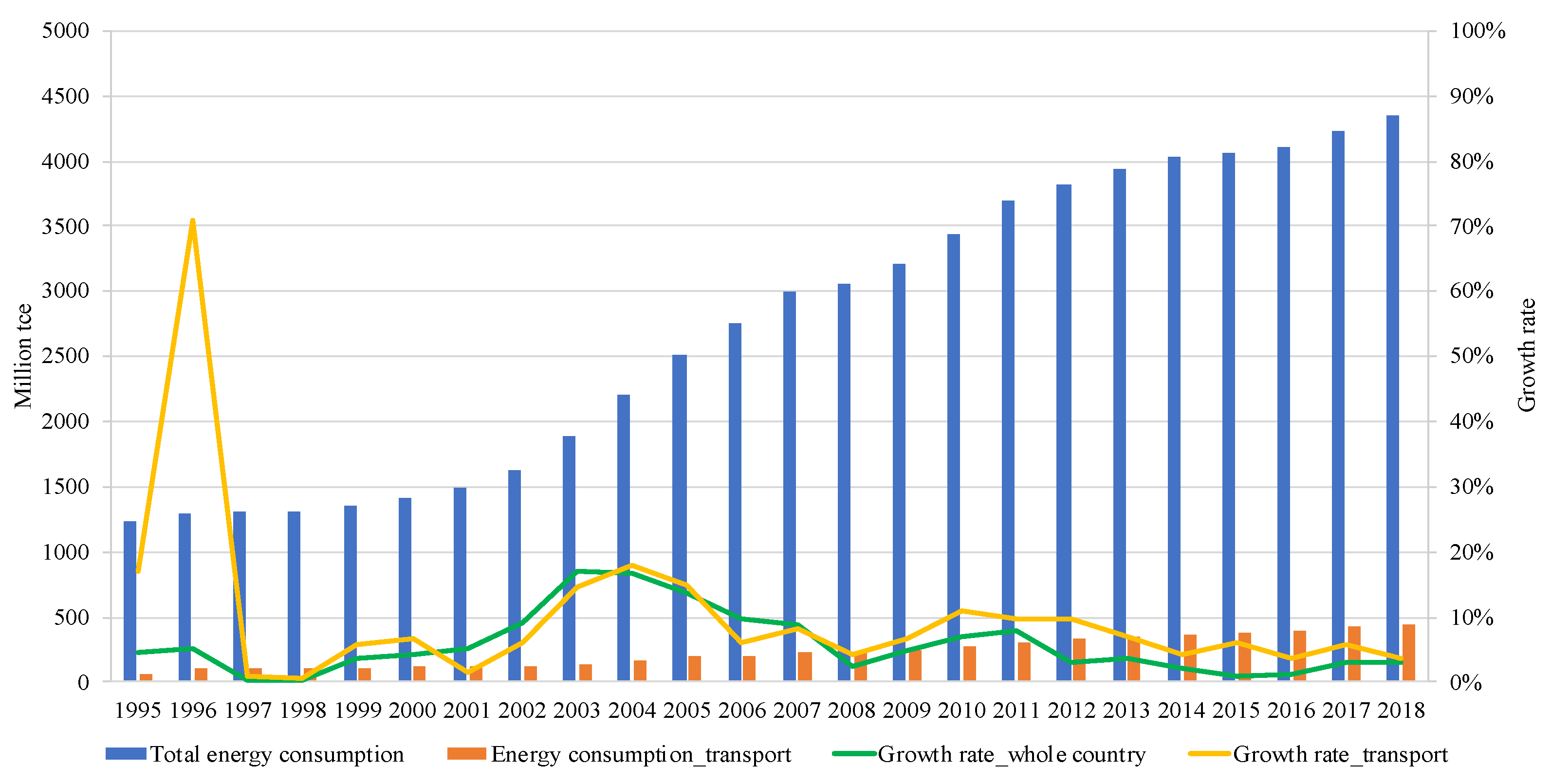
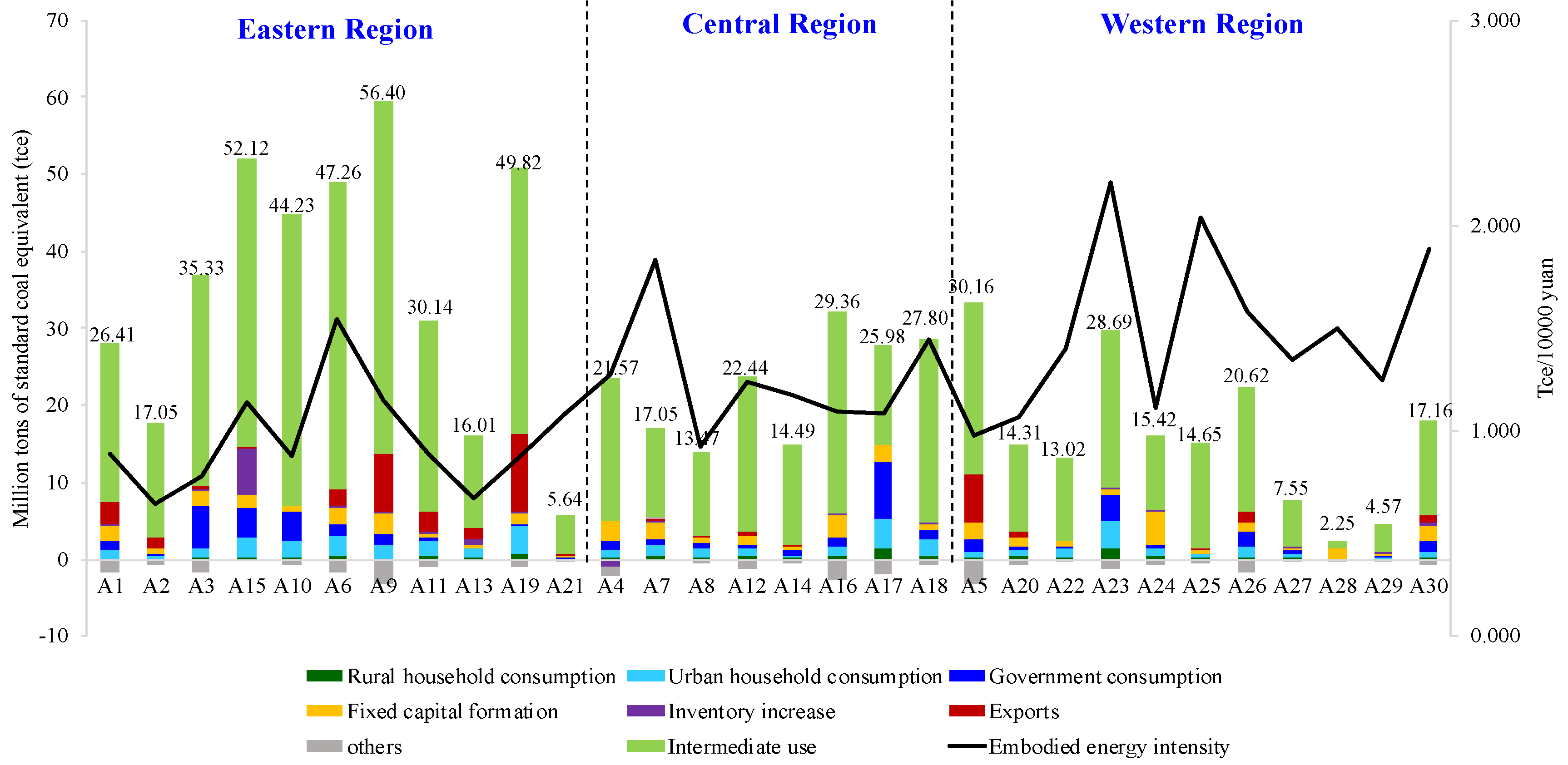
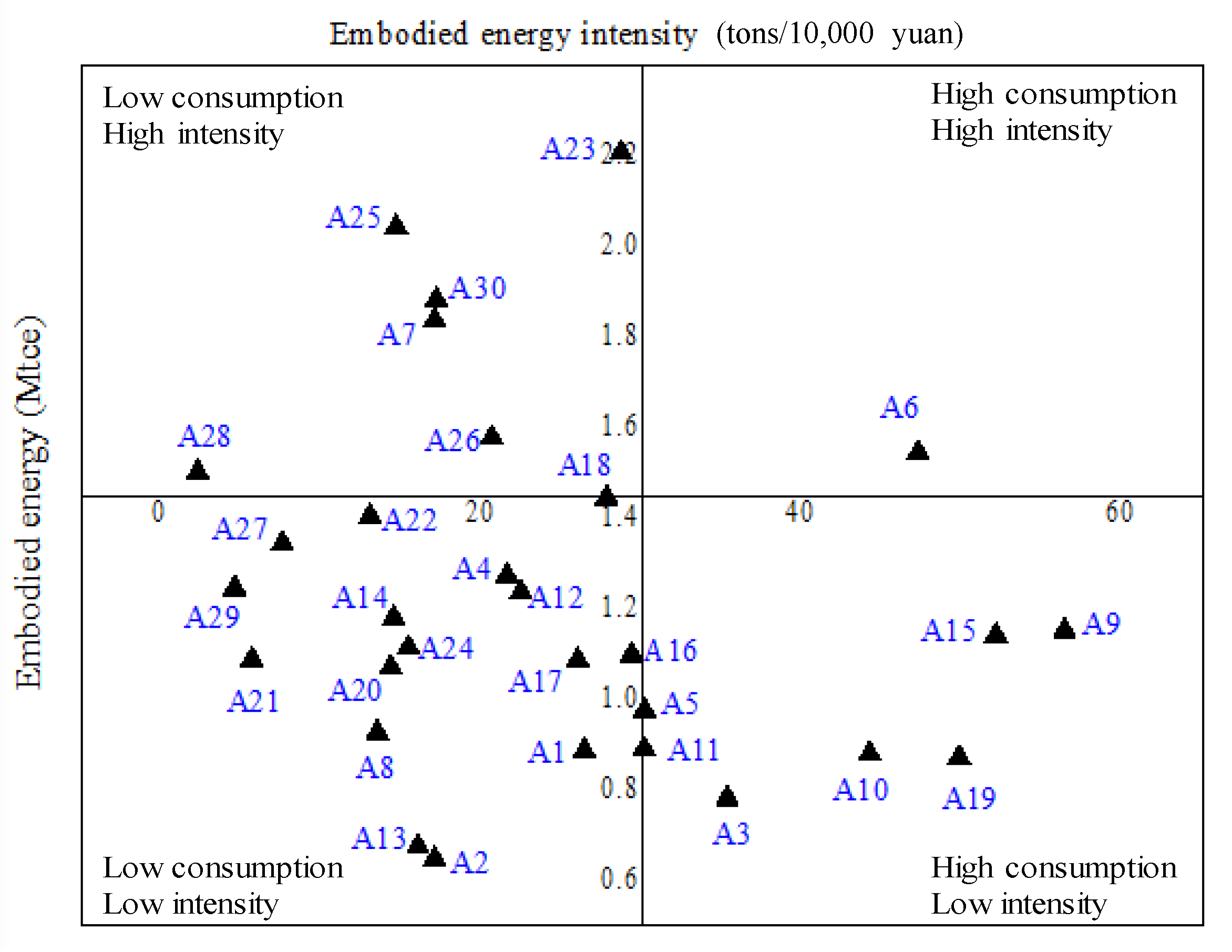

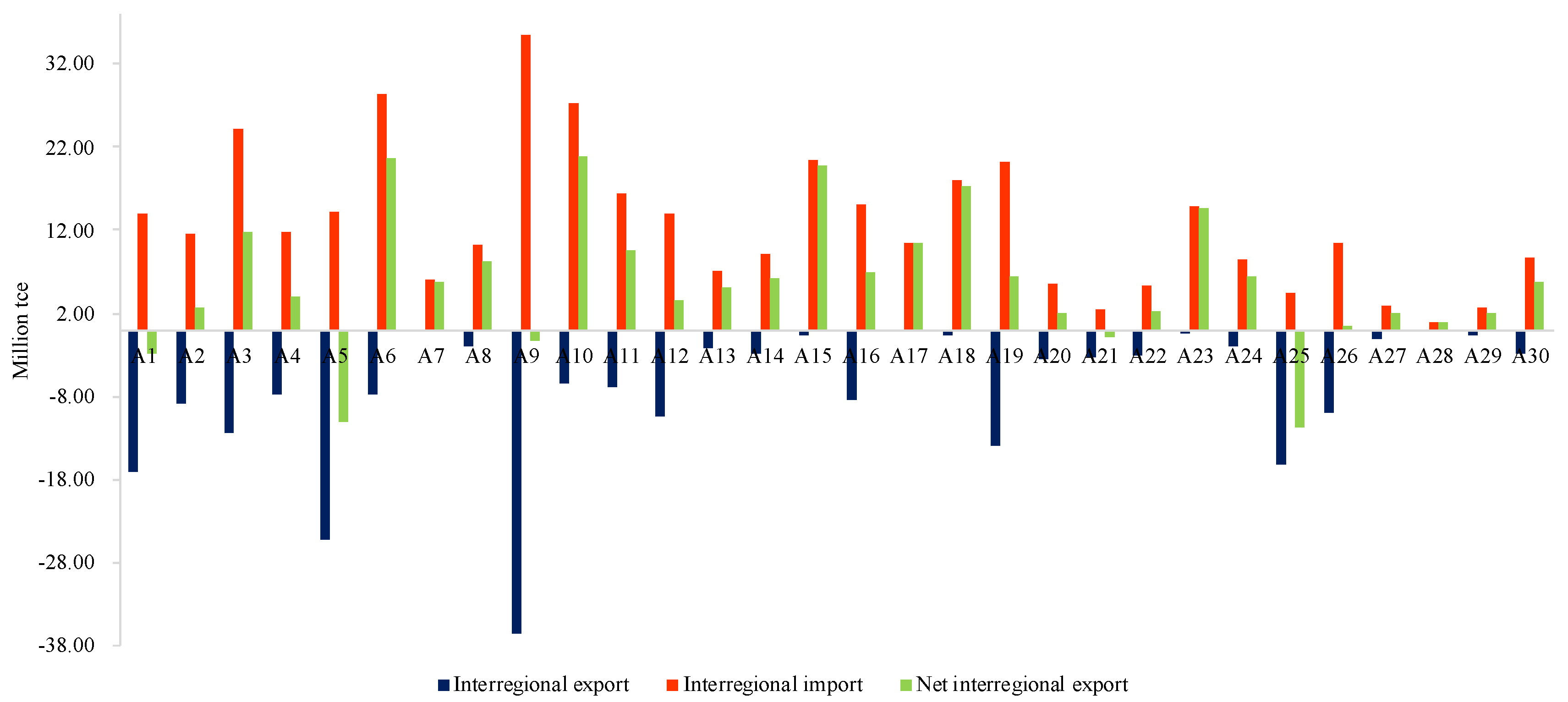
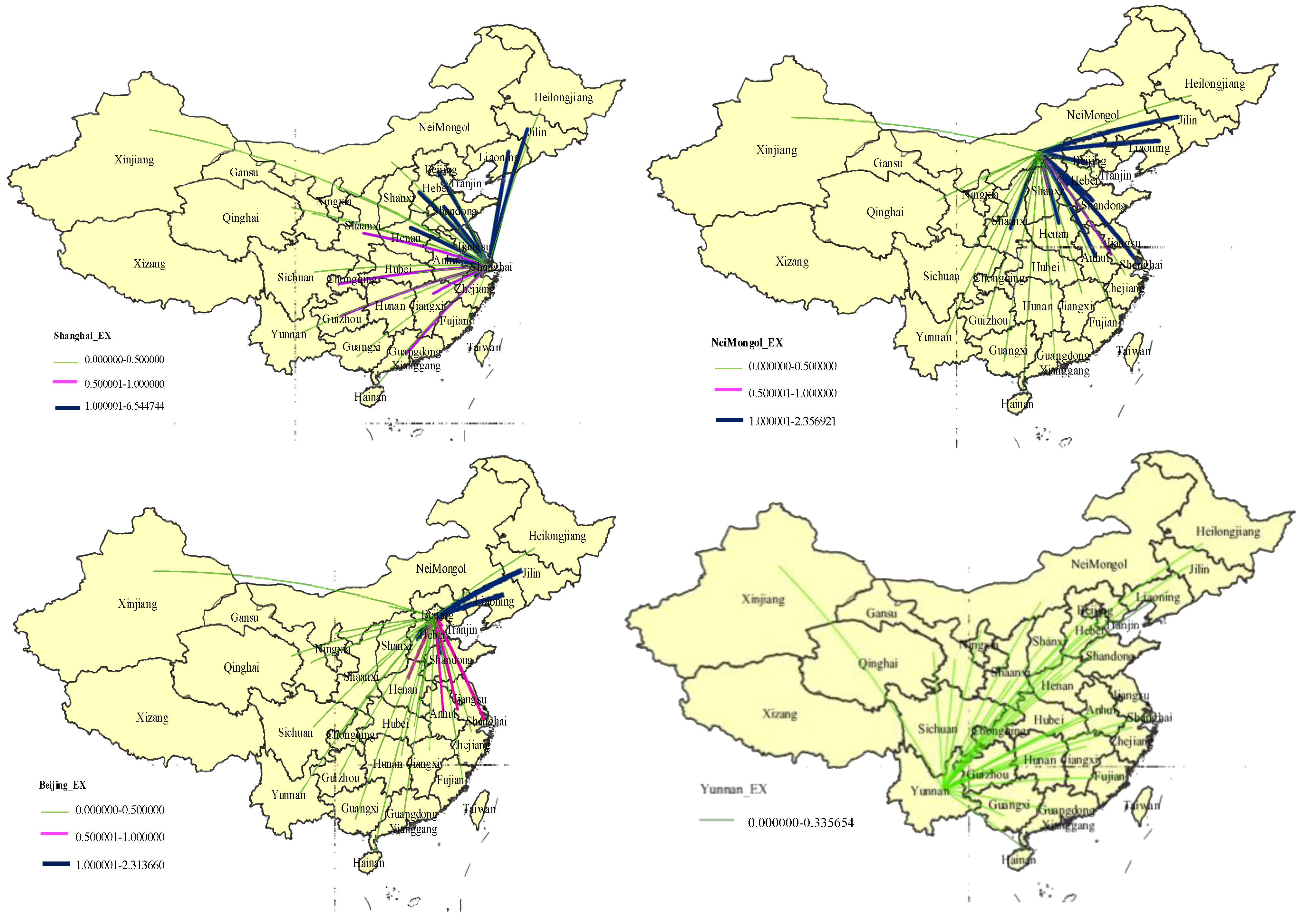
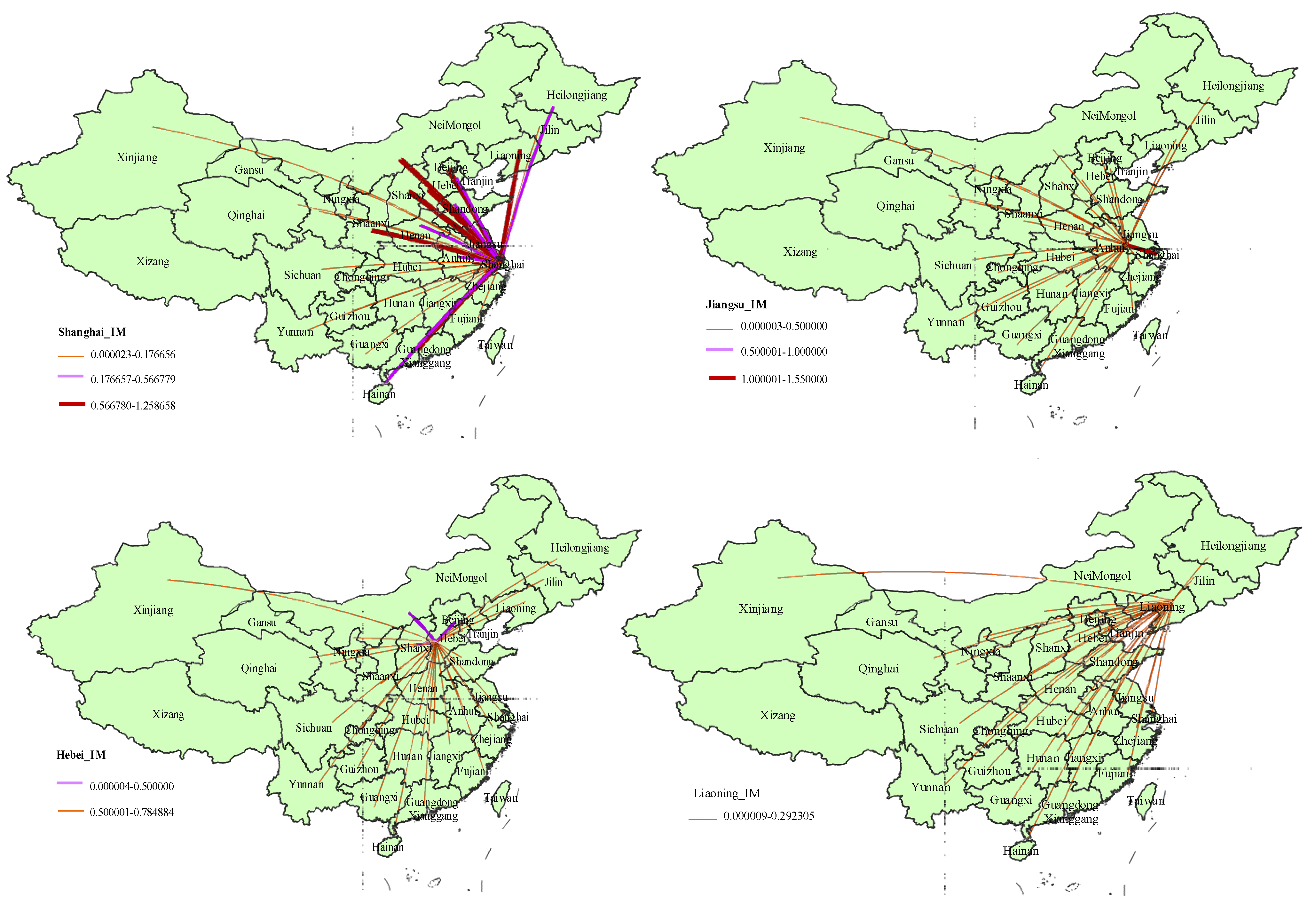
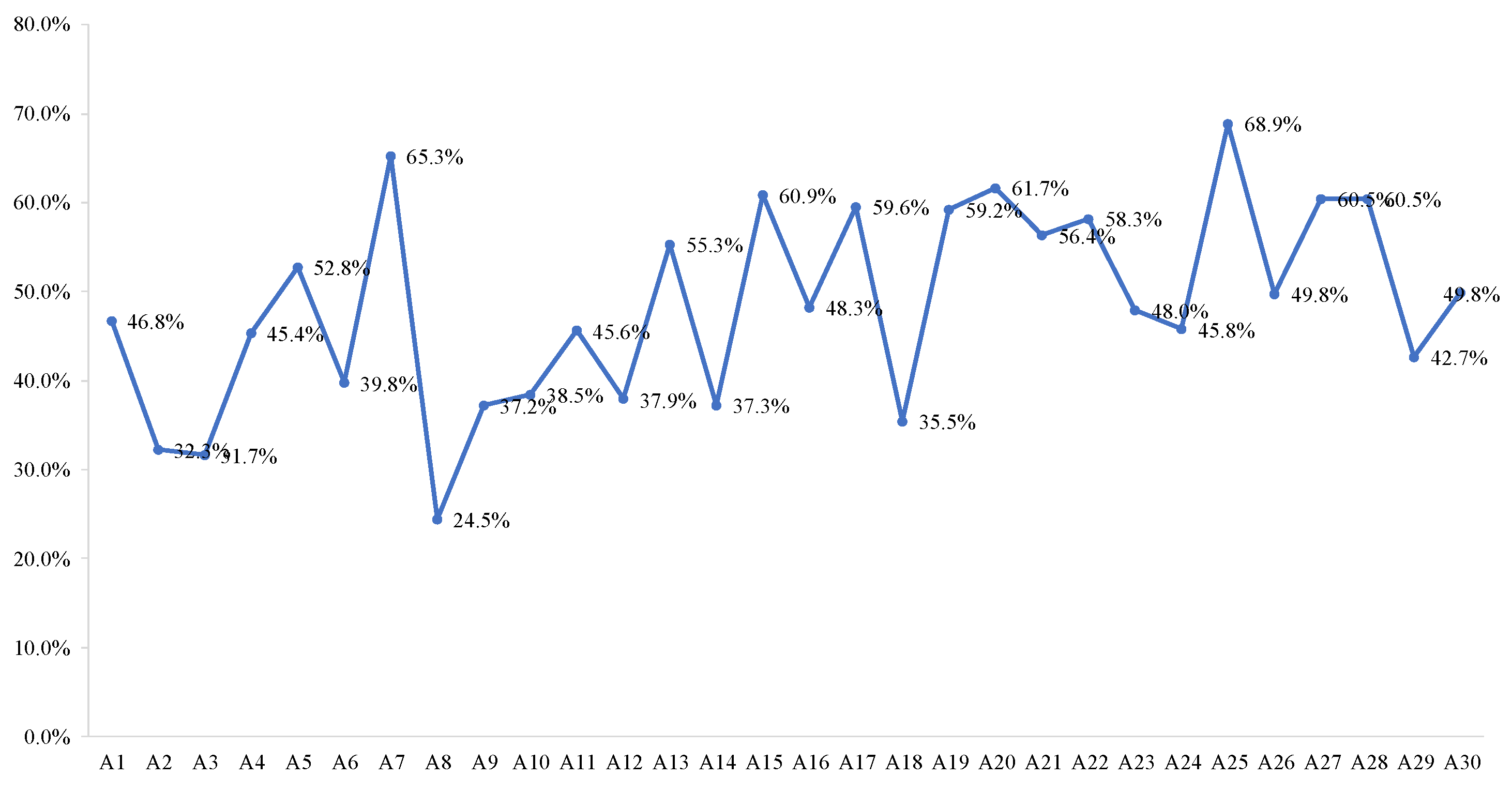
| Output | Intermediate Use | Final Use | Total Output | |||||||||||||||
|---|---|---|---|---|---|---|---|---|---|---|---|---|---|---|---|---|---|---|
| Input | Province 1 (A1) | Province 2 (A2) | … | Province m (Am) | Domestic Final Use | Foreign Demand | Others | |||||||||||
| S1 | … | Sn | S1 | … | Sn | S1 | … | Sn | Province 1 (A1) | Province 2 (A2) | … | Province m (Am) | Exports | |||||
| Province 1 (A1) | S1 | |||||||||||||||||
| S2 | ||||||||||||||||||
| … | ||||||||||||||||||
| Sn | ||||||||||||||||||
| Province 2 (A2) | S1 | |||||||||||||||||
| S2 | ||||||||||||||||||
| … | ||||||||||||||||||
| Sn | ||||||||||||||||||
| … | ||||||||||||||||||
| Province m (Am) | S1 | |||||||||||||||||
| S2 | ||||||||||||||||||
| … | ||||||||||||||||||
| Sn | ||||||||||||||||||
| Direct energy input | ||||||||||||||||||
Publisher’s Note: MDPI stays neutral with regard to jurisdictional claims in published maps and institutional affiliations. |
© 2021 by the authors. Licensee MDPI, Basel, Switzerland. This article is an open access article distributed under the terms and conditions of the Creative Commons Attribution (CC BY) license (https://creativecommons.org/licenses/by/4.0/).
Share and Cite
Li, J.; Fang, H.; Fang, S.; Zhang, Z.; Zhang, P. Embodied Energy Use in China’s Transportation Sector: A Multi-Regional Input–Output Analysis. Int. J. Environ. Res. Public Health 2021, 18, 7873. https://doi.org/10.3390/ijerph18157873
Li J, Fang H, Fang S, Zhang Z, Zhang P. Embodied Energy Use in China’s Transportation Sector: A Multi-Regional Input–Output Analysis. International Journal of Environmental Research and Public Health. 2021; 18(15):7873. https://doi.org/10.3390/ijerph18157873
Chicago/Turabian StyleLi, Jing, Hong Fang, Siran Fang, Zhiming Zhang, and Pengyuan Zhang. 2021. "Embodied Energy Use in China’s Transportation Sector: A Multi-Regional Input–Output Analysis" International Journal of Environmental Research and Public Health 18, no. 15: 7873. https://doi.org/10.3390/ijerph18157873
APA StyleLi, J., Fang, H., Fang, S., Zhang, Z., & Zhang, P. (2021). Embodied Energy Use in China’s Transportation Sector: A Multi-Regional Input–Output Analysis. International Journal of Environmental Research and Public Health, 18(15), 7873. https://doi.org/10.3390/ijerph18157873







